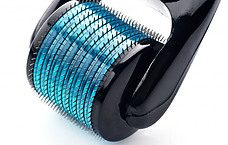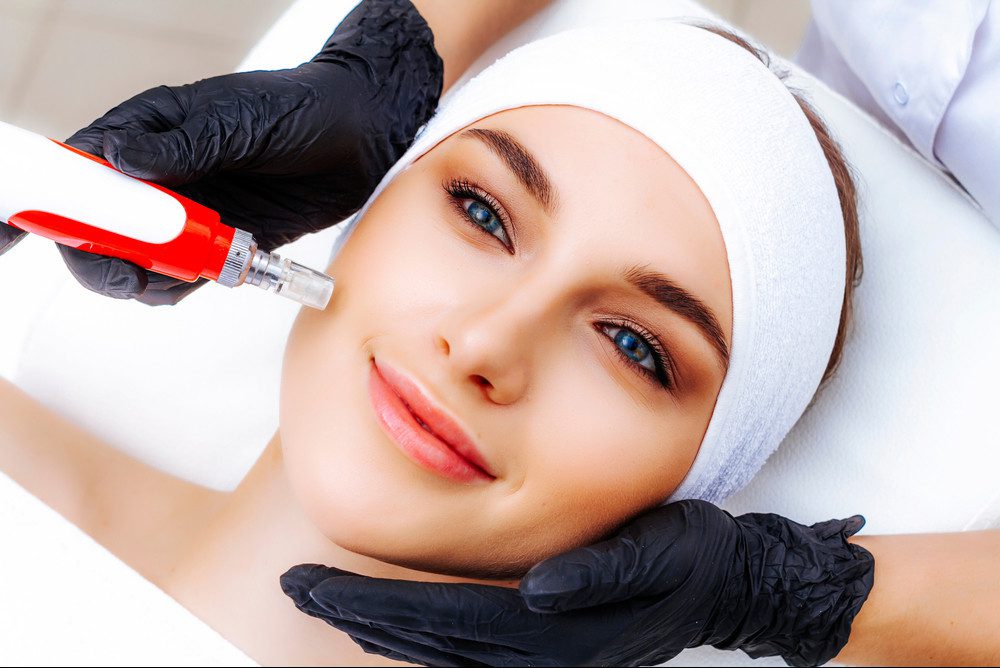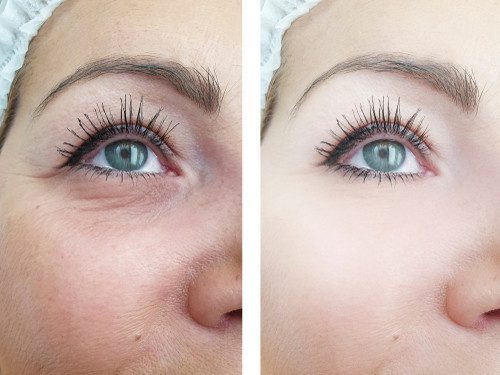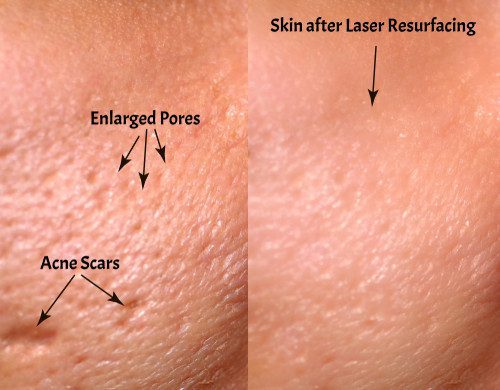
Microneedling and laser therapy are very different from each other. In this post, I will explain the difference in the treatments, the treatment procedures, any side effects, and the benefits of each for your skin.
What is microneedling?
Microneedling is where you prick your skin with teeny, tiny, sterilized needles. Also called collagen induction therapy, it creates thousands of tiny channels of injury that force healing of the skin by causing your body to make more collagen and elastin.

Microneedling can be done by a professional or at home. It is safe for all skin types and recovery is only 1-2 days.
What are the benefits of microneedling?
Microneedling will address issues like acne, dark spots, skin laxity, sun damage, scars, large pores, stretch marks, fine lines, wrinkles, and hair loss.
Microneedling is way less expensive than laser treatments.
When performed by a professional
The procedure will usually take about 10 to 20 minutes (depending on the area being treated) and it generally takes 4 to 6 treatments to notice a difference. During the procedure, the professional will spread a numbing cream all over the clean area (usually the face, but other areas can be treated as well).
An actual professional knows this, but be aware that the equipment being used is sterilized.
They will then use a pen-like tool or roller with tiny needles. The needles on the professional tools are longer than the ones used at home and there may be some bleeding. They may combine the procedure with PRP (platelet-rich plasma). This can be applied during the microneedling or injected directly into the treated area and also helps boost collagen production.
The PRP injections have also been referred to as a “vampire facial”.
After the procedure, they will spread a serum or cream on the area treated.
Be sure to wear SPF 30 or above to protect your skin.
At home procedure
Make sure the area is clean and make sure you have sterilized your tools.
Afterward, you can apply your serums and creams.
Make sure to wear SPF 30 or above and reapply as needed.
Side Effects and Cost
With a professional treatment, you may have some pain, redness, peeling, bruising, and bleeding. There is a risk of infection, but it is low when done by a professional with sterile equipment.
Microneedling is not a good idea for those who have keloid scarring, it can make the condition worse.
The needles for the at-home pens and rollers are shorter and duller, so, the side effects won’t be as pronounced. Just be sure to sterilize properly. To sterilize your own derma roller, soak in 70% isopropyl alcohol for 5-10 minutes.
Cost
Microneedling is a cosmetic procedure, so it won’t be covered by insurance. Depending on the area you are having treated, a session can be anywhere from $200-$700.
You may also have a session used in conjunction with other treatments, such as radiofrequency, which may also affect the cost.
As an Amazon affiliate, I may earn a small commission on purchases made through the links. Full disclosure.
Derma rollers for home use can start at $10 and go up. Get your derma roller kit here. A derma pen costs a little bit more, starting around $40, but is also more effective. Get your derma pen here.
Learn exactly how to use your derma roller here.
Microneedling FAQ’s
How long does microneedling last?
Once you have reached the desired effects, they last from 3 to 5 months. Most go twice a year to maintain collagen production.
When will you see improvements?
After one session, many notice improvement in skin tone and texture and a reduction in acne.
How many treatments should you have?
To achieve the desired effect, you may need 3 to 6 treatments.
What is Laser Skin Resurfacing?
Laser skin resurfacing is a precise way of removing the skin layers. There are two types called ablative and non-ablative.
Ablative lasers provide the best results because they are more intense and vaporize the skin. Non-ablative isn’t as intense, doesn’t destroy the skin, and may require multiple treatments for the desired effect.
Laser treatments can be compared to chemical peel because they both take off the old skin to promote new, healthy skin.
How effective is laser therapy?
Even though laser resurfacing won’t wield the results as a facelift, people who have had the procedure said their skin looked plumper, softer, smoother, and more moisturized. They also stated their age spots, wrinkles, and dullness were less noticeable.
Remember, though, that ablative lasers are going to go deeper into the skin than non-ablative ones.
Laser skin resurfacing is performed by a dermatologist, plastic surgeon, or physician and is recommended to address issues such as age spots, enlarged pores, crow’s feet, scars, fine lines, wrinkles, sagging skin, and uneven skin tone.
Certifications the professional should have are either from the American Board of Dermatology (ABD), American Board of Plastic Surgery (ABPS), or the American Osteopathic Board of Dermatology (AOBD).

With laser therapy, you can treat just the specific areas like around your eyes, mouth, or forehead or you can treat your whole face.
What are the side effects of laser therapy?
Depending on which laser you choose, the side effects may be mild to moderate. Side effects may include redness, swelling, itching, and pain, with the redness lasting for several months.
Other side effects include a worsening of acne from applying thick creams or bandages or you may develop tiny white bumps, also known as milia.
There is a risk of bacterial, viral, or fungal infection, especially in those prone to cold sores. The procedure can cause a flare-up of the herpes virus.
Your skin can also be at risk of becoming darker (hyperpigmentation) or lighter (hypopigmentation) especially in those with darker to black skin.
There can also be a low risk of scarring with ablative laser resurfacing.
Not everyone can get laser resurfacing
If you decide you would like to consider giving laser resurfacing a try, your doctor may caution you against it if you have any of the following:
- History of keloid scars
- Taken isotretinoin, an acne medication, in the last year
- Pregnant or breastfeeding
- Have connective tissue, autoimmune disease, or a weakened immune system
- History of ectropion (outward-turning eyelid)
- Had radiation therapy on the face
- Prone to cold sores
- Have darker brown, black, or very tan skin
- Previous laser resurfacing
Before, During, and After the Procedure
Before the procedure, your doctor may start you on skin treatments 6 weeks before the procedure date to prepare your skin. If you are prone to cold sores, the doctor may prescribe medication a couple of weeks before the procedure to prevent complications.
If you smoke, you will need to stop about 2 weeks before the procedure to avoid complications and help your body heal.
Your doctor will give you any additional steps prior to the procedure.
On the day of the procedure, your doctor will first numb your skin. Your skin will be cleansed thoroughly and you will be given eye protection.
If you are having extensive laser resurfacing, you may be sedated or given a general anesthetic. Depending on what you are having done, the procedure may take 30 mins. to 2 hours.
If you have the non-ablative laser treatment, you will be scheduled for 1-3 more treatments to obtain the results you are looking for.
After the procedure
If you opted for ablative laser resurfacing, your doctor will apply a thick ointment to the treated skin and may apply an airtight and watertight dressing because of your skin being raw, swollen, and itchy. You may also be prescribed painkillers and use ice packs.
You don’t want to use anything that could irritate your skin or let it come in contact with anything that could cause an infection.
Wearing protection from the sun is a must.
Full recovery can take up to a month and your skin can stay inflamed for several months.
For non-ablative laser resurfacing, your skin may be swollen and inflamed for just a little while afterward. You may use ice packs if needed and definitely use sun protection.
How long do the results last from laser resurfacing?
Typically, the results from a laser peel last from 3 to 5 years. However, there are ways to extend your results beyond the 5-year mark.
- Protect your skin from the sun. Use SPF 30 or above always.
- Boost your skin’s antioxidant levels. Add vitamins and mineral supplements to your diet and antioxidant skin care.
- Eat a healthy diet. The types of food you eat can have a major impact on your skin’s health. Foods rich in vitamins A & C are recommended.
- Keep yourself hydrated. Staying hydrated helps keep proper blood flow to your skin and keeping toxins flushed from the body.
- Follow an effective anti-aging routine both morning and night. Keep your skin moisturized and exfoliate regularly.
- Exercise regularly to stimulate human growth hormone, which will also boost collagen production. Find ways to keep stress levels at bay, such as meditation.
Related: Learn how to do your own chemical peel at home.
Cost
According to plasticsurgery.org, the average cost for ablative laser resurfacing is around $2,500 and $1500 for non-ablative. The costs may differ depending on where they are located, expertise, the type of procedure used, the time it takes, and the effort to perform the procedure.
There may be additional costs, such as surgical facility, anesthesia fees, and medications prescribed. Insurance rarely covers cosmetic procedures.
Final Thoughts
As you have now learned, with microneedling, the results will be more gradual and may take more time to achieve your desired results. Whereas with laser resurfacing, your results will be immediate but you may have some downtime and recovery to plan for.
Another factor to consider will be your budget or the amount of money you are willing to spend on a cosmetic procedure.
I hope this has helped answer any questions you may have about either procedure. If you still have questions, comments, or any suggestions, please leave them below.
Want to create your own blog? Read this.
I have been thinking to get my own kit and try this at home however I wonder how safe it actually is. I also have a rugby complexion, so won’t I perhaps make it worse for myself.
There definitely seems to be more pros than cons involved here and they say your products are absorbed far more effectively when you do micro needling on your skin.
You are right, the micro needling makes little channels so your skincare products absorb deeper into your skin.
Hi Thank you for this great article. I’m glad I came across your website as I have been looking at having some procedures and you have made it easy for me to make a decision. I can’t wait to read more from you and I will definitely be sharing this with my friends as they will find this helpful. I look forward to seeing more content from you! 🙂
Thank you, I am glad you found it helpful. Thank you for sharing this as well.